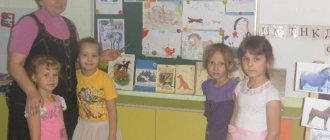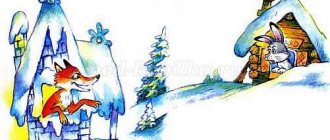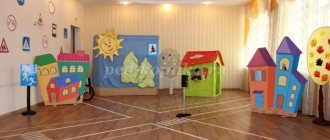Progress of the lesson:
Educator. What do you think is in it? (children's answers)
Educator. Let's get a look. Guys, this is a fairy tale . Let's think about who this fairy tale ? Right. It's about the kolobok . And the bun invites us to read it. Well, let's read a fairy tale about a kolobok ?
Educator. Then listen (reads a fairy tale about a bun )
.
Educator. How do you guys like the fairy tale ? Did you like it? (children's answers)
Educator. What was the kolobok ?
Educator. And who cooked it up?
Educator. Where did grandma put it when she baked it?
Educator. Where did he go?
Educator. Whom did you meet on your way? (children's answers)
Educator. What did the hare, wolf and bear tell him? (children's answers)
Educator. What did the fox say ? (children's answers)
Educator. How did his journey end? (children's answers)
Educator. Right. We are making him many new friends, just like him. But before we get to work, let's play a little with our kolobok and cheer him up.
We came to visit a fairy tale
Found a chest with a lock
And they sat down and stood up,
And they jumped like a bunny.
Let's stretch our hands,
Educator. Well done. Now let's get to work (children together with the teacher make koloboks )
.
Educator. Well done boys. These are the beautiful koloboks we made . Now our bun will not be bored . How many friends does he have (exhibition of works)
.
Photo report on the dramatization of the Russian folk tale “Kolobok” “The theater is a magical world.
He gives lessons in beauty, morality and ethics. And the richer they are, the more successful the development of the spiritual world is. Photo report on the game-dramatization of the Russian folk tale “Kolobok” Photo report on the game dramatization of the Russian folk tale “Kolobok” To begin with, we decided to refresh our memory of the text of the fairy tale. Kids pay attention. Photo report on the staging of the Russian folk tale “Kolobok” with children 2–4 years old h3] Purpose: to teach to imitate the voices of animals. Strengthen your knowledge of Russian folk tales. Practice pronouncing individual phrases. Bring up. Summary of educational activities on speech development for children of primary preschool age. Reading the Russian folk tale “Rukavichka” Tsviklo Irina Vasilyevna, teacher of the Nazyvaevsky Kindergarten No. 1, Nazyvaevsk, Omsk Region Abstract of directly educational. Abstract of the GCD in the junior group “Reading the Russian folk tale “The Wolf and the Seven Little Goats”” Speech development. Fiction. Topic: Reading the Russian folk tale “The Wolf and the Seven Little Goats.” Goal: Acquaintance with Russian folk.
Summary of educational activities for speech development in the middle group. Reading the Russian folk tale “The Cockerel and the Bean Seed” Summary of GCD in the middle group for speech development. Reading the Russian folk tale “The Cockerel and the Bean Seed.” Integrated lesson p.
Source
Progress of the lesson:
-Guys, I want to tell you a riddle, and you try to guess it.
Round side, ruddy side
Who is this? ( Kolobok )
.
Look, he came to visit us (a fake kolobok )
.
Guys, what shape is Kolobok ? (Round)
- Come on, you and I will find more round-shaped objects on the table
Didactic game “Round shape”
Objects of different shapes are laid out on the table. Children should choose those that are round in shape.
- Well done, what is the name of the fairy tale where the main character is Kolobok ? ( " Kolobok "
).
-Yes. This is a Russian folk tale , which is called “ Kolobok ”
.
If you want, guys, I’ll tell you and show you this fairy tale , and you’ll help me.
The teacher organizes a tabletop fairy tale , the children help name the order in which the characters appear, pronounce the words in the song Kolobok .
- Well done guys, remember the fairy tale . Now let’s warm up a little and do some physical education.
The bear has a big house (raise your arms up, rise on your toes,
And the hare has a small one (crouching, extend your arms in front of you,
Our bear went home (step from foot to foot,
And behind him comes the bunny (jumping)
.
We are seeing off the animals (we wave our hand)
And we continue the lesson .
Didactic game “Who is missing”
The teacher leaves all the fairy tale and draws the children’s attention to which characters stand where. He invites you to close your eyes, removes one of the heroes, the children open their eyes and guess who is hiding.
- Well done guys, you did it. But the grandparents were very upset that the fox ate Kolobok . Let's make them new Koloboks from plasticine .
In order for the hands to sculpt well, we need to do gymnastics for the fingers.
We made the dough ourselves
Like this, like this (we show how to knead the dough)
We baked the bun ourselves
Like this, like this (we show how to make a Kolobok )
- Guys, what color of plasticine should you take to make Kolobok ? (yellow)
.
- Right, why? (because it was roasted in the oven)
- Now watch how I will sculpt Kolobok .
First, let's knead our plasticine so that it becomes soft. Now you can sculpt Kolobok . Place it on your palm, hold it with your other palm and roll it out in a circular motion.
After the show, the children make a Kolobok , rolling out a lump of plasticine in their palms in a circular motion.
- Well done guys, how hard you tried! Koloboks the grandparents now have . Now they definitely won’t be sad and say “Thank you!”
And our
lesson has come to an end .
Summary of a lesson on reading fiction on the topic “Russian folk tale “The Snow Maiden”” Integration of educational areas: Cognitive, speech, artistic and aesthetic development Goal: Awareness of one’s emotional.
Summary of a lesson on reading fiction in the senior group based on the story by N. Nosov “The Living Hat” Summary of a lesson on reading fiction in the senior group based on the story by N. Nosov “The Living Hat”. Goal: mastering the basics.
Summary of GCD in the second junior group based on the fairy tale “Kolobok”
Marina O
Summary of GCD in the second junior group based on the fairy tale “Kolobok”
To work with the comprehensive program “From birth to school”
edited by
N. E. Veraksy, T. S. Komarova, M. A. Vasilyeva.
Age group : second youngest
Topic: " Fairy tale " Kolobok "
Leading educational field: cognitive
Goal: developing the ability to identify the main characters and the sequence of the main episodes of a literary text.
Objectives: consolidate knowledge of the Russian folk tale “ Kolobok ”
; to form children’s ability to emotionally perceive the figurative basis of a poetic work;
Developmental: activate speech; develop the ability to answer questions and draw conclusions.
Educational: to cultivate restraint, perseverance, goodwill.
Cognitive: consolidate children’s knowledge about wild animals, actions and actions, their consequences
Educational: promote the development of speech, thinking, attention; ability to construct sentences and answers; consolidate knowledge of animal names
Types of children's activities: productive, artistic, theatrical
Technology: theatrical, health preservation.
Forms of organization: group
Form of implementation: theatrical performance, demonstration of illustrative aids; searching and problematic questions for children, encouragement, explanation, leading to a conclusion; surprise moment, active dialogue between children.
Equipment: book with illustrations, pictures depicting the main characters of the fairy tale and wooden figures ( kolobok , hare, wolf, bear, fox, woman and grandfather)
.
Integration of educational areas: communicative, artistic and aesthetic development (perception of a work of art, motor, play.
Preliminary work: "get"
letter from the sorceress (in the envelope “The Good Fairy invites you to go on a
fabulous journey on Thursday.”)
Reading the fairy tale "Kolobok". Lesson in the younger group
Yulia Kholodnaya
Reading the fairy tale “Kolobok”. Lesson in the younger group
Reading the fairy tale " Kolobok "
.
Lesson in the younger group
Teacher Kholodnaya Yu. Yu.
Reading the fairy tale “ Kolobok ”.
Goal: to teach to listen carefully to a work of art, to perform the game exercise “ Kolobok hot and cold .”
Planned results. Perform movements corresponding to the game exercise “ Kolobok hot and cold .”
Materials and equipment: book, ball.





